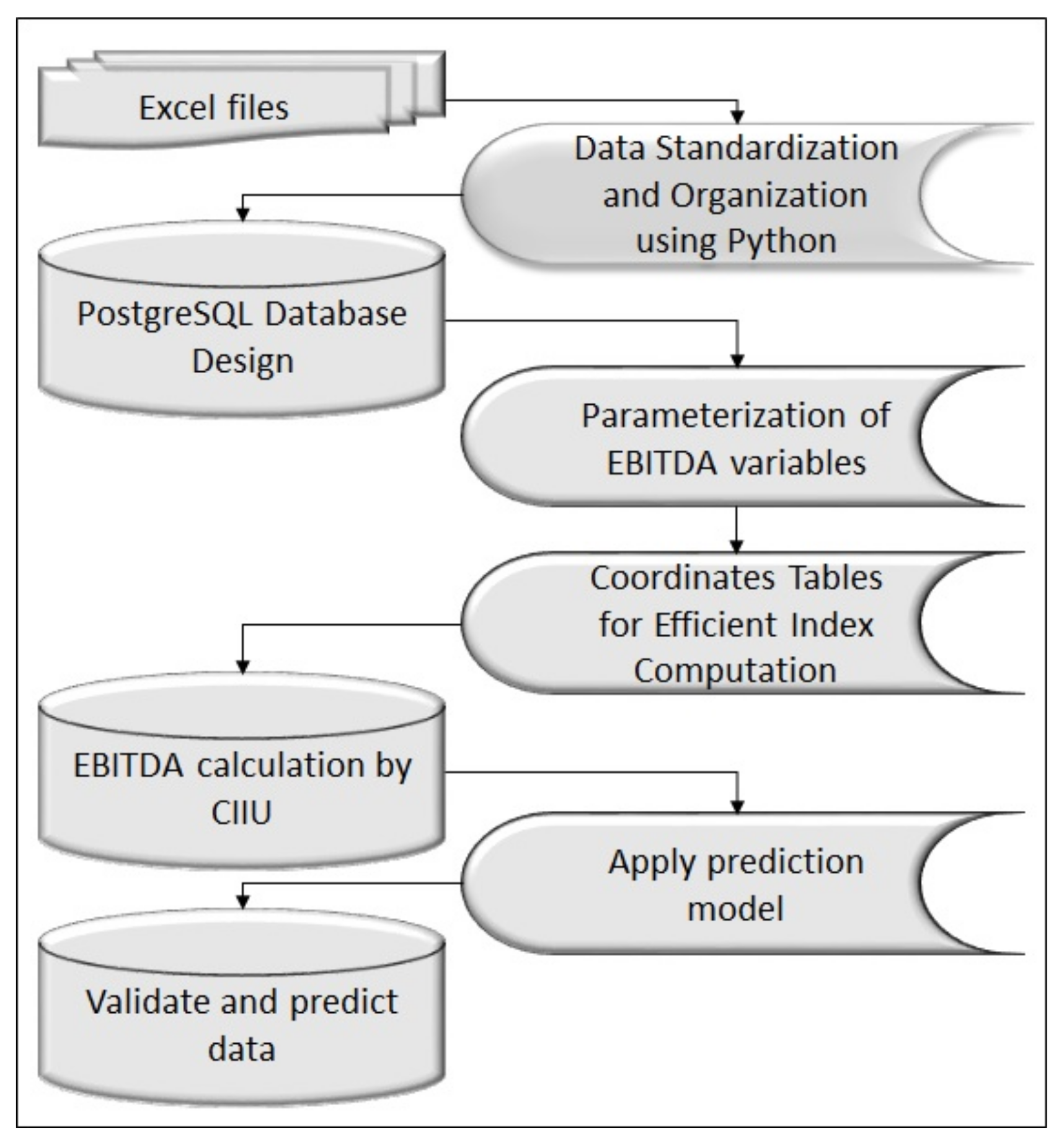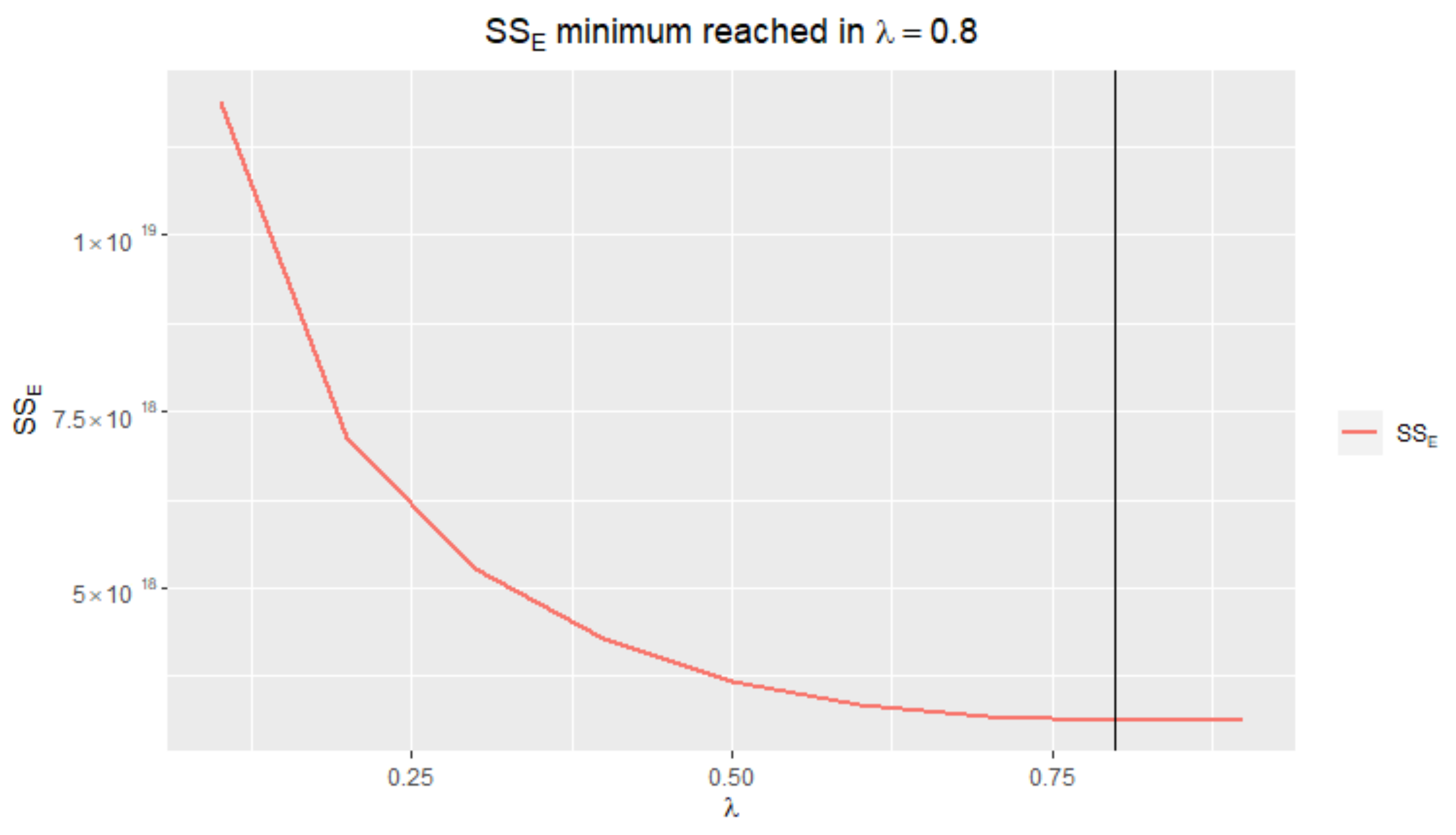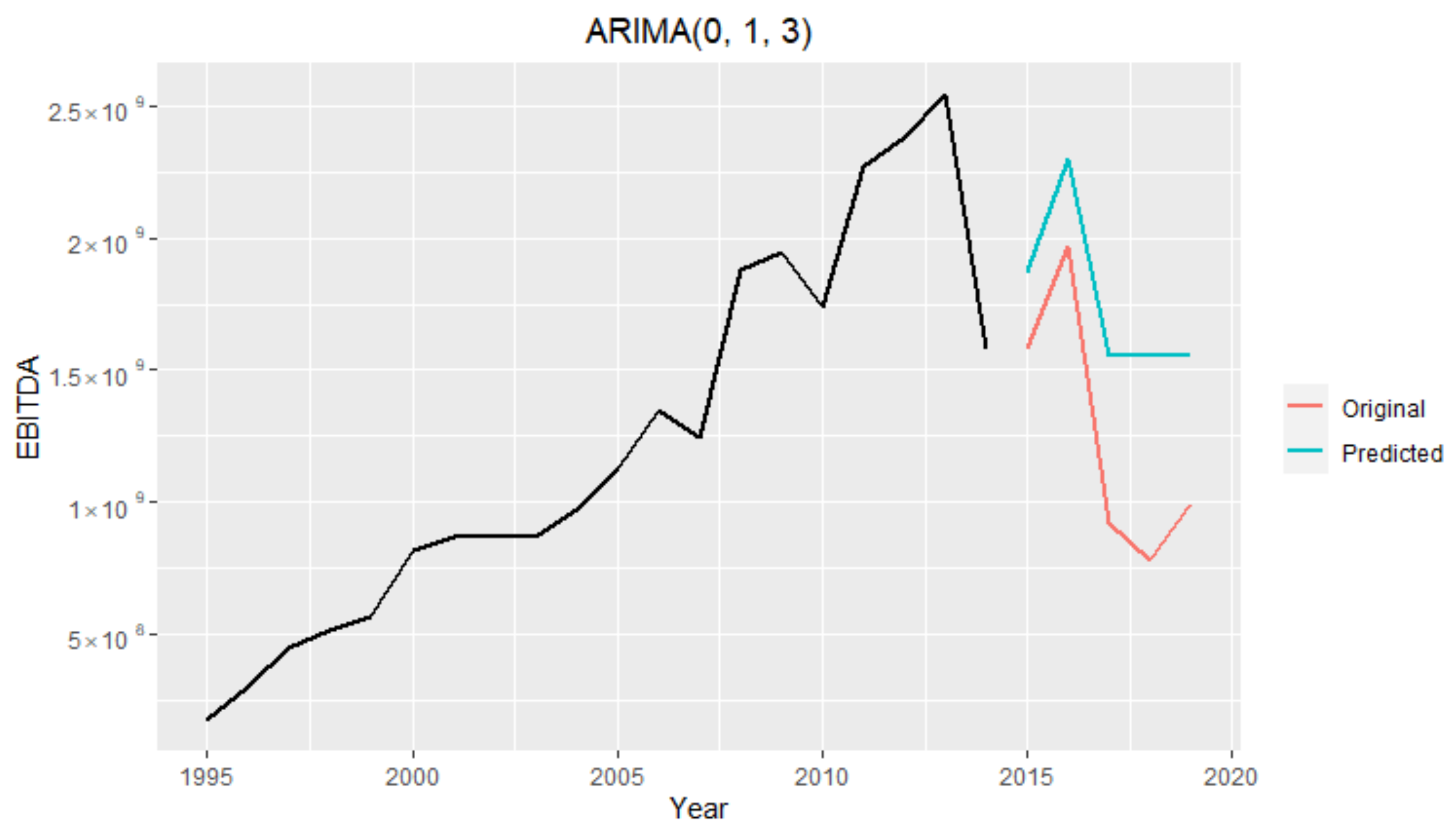EBITDA Index Prediction Using Exponential Smoothing and ARIMA Model
Abstract
:1. Introduction
2. Materials and Methods
Technical Specifications
3. Predictive Analytics
4. Model Selection
4.1. Simple Exponential Smoothing
4.2. Second Order Exponential Smoothing
4.3. ARIMA Models
4.4. Accuracy Metrics
5. Forecasting
5.1. Constant Process
5.2. Linear Process
5.3. ARIMA Forecasting
6. Results
7. Summary and Conclusions
Author Contributions
Funding
Institutional Review Board Statement
Informed Consent Statement
Data Availability Statement
Conflicts of Interest
References
- Crnjac, M.; Veža, I.; Banduka, N. From concept to the introduction of industry 4.0. Int. J. Idustrial Eng. Manag. 2017, 8, 21. [Google Scholar]
- Pereira, A.; Romero, F. A review of the meanings and the implications of the Industry 4.0 concept. Procedia Manuf. 2017, 13, 1206–1214. [Google Scholar] [CrossRef]
- Andieva, E.Y.; Ivanov, R. Constructing the measuring system in industry 4.0 concept. In Journal of Physics: Conference Series; IOP Publishing: Bristol, UK, 2019; Volume 1260, p. 032002. [Google Scholar]
- Ivanov, I.; Luk’yanova, T.; Belova, O. Digital Economy: Knowledge in the Logic of the Industry 4.0 Concept. In Proceedings of the 13th International Scientific and Practical Conference-Artificial Intelligence Anthropogenic Nature vs. Social Origin, Volgograd, Russia, 19–20 March 2020; Springer: Cham, Switzerland; pp. 50–59. [Google Scholar]
- Ahmad, S.; Miskon, S.; Alabdan, R.; Tlili, I. Towards Sustainable Textile and Apparel Industry: Exploring the Role of Business Intelligence Systems in the Era of Industry 4.0. Sustainability 2020, 12, 2632. [Google Scholar] [CrossRef] [Green Version]
- Jiang, H. Research on the Development of an Intelligent Financial Management System Based on Data Mining Technology. In Journal of Physics: Conference Series; IOP Publishing: Bristol, UK, 2020; Volume 1578, p. 012062. [Google Scholar]
- Chlomou, G.; Demirakos, E. How do financial analysts implement the Sum-of-the-Parts (SOTP) valuation framework? Int. Rev. Financ. Anal. 2020, 70, 101514. [Google Scholar] [CrossRef]
- Ozturk, H.; Karabulut, T.A. Impact of financial ratios on technology and telecommunication stock returns: Evidence from an emerging market. Invest. Manag. Financ. Innov. 2020, 17, 76. [Google Scholar] [CrossRef]
- Tamulevičienė, D.; Androniceanu, A. Selection of the indicators to measure an enterprise’s value and its changes in the controlling system for medium-sized enterprises. Entrep. Sustain. Issues 2020, 7, 1440–1458. [Google Scholar] [CrossRef] [Green Version]
- Schueler, A. Valuation with Multiples: A Conceptual Analysis. J. Bus. Valuat. Econ. Loss Anal. 2020, 1. [Google Scholar] [CrossRef]
- Bouwens, J.; De Kok, T.; Verriest, A. The prevalence and validity of EBITDA as a performance measure. Comptabilité-Contrôle-Audit 2019, 25, 55–105. [Google Scholar] [CrossRef]
- Rozenbaum, O. EBITDA and managers’ investment and leverage choices. Contemp. Account. Res. 2019, 36, 513–546. [Google Scholar] [CrossRef] [Green Version]
- Vidal-Garcia, R.; Ribal, J. Terminal Value in SMEs: Testing the Multiple EV/EBITDA Approach. J. Bus. Valuat. Econ. Loss Anal. 2019, 14. [Google Scholar] [CrossRef]
- Box, G.E.; Jenkins, G.M.; Reinsel, G.C.; Ljung, G.M. Time Series Analysis: Forecasting and Control; John Wiley & Sons: Hoboken, NJ, USA, 2015. [Google Scholar]
- Williams, B.M.; Durvasula, P.K.; Brown, D.E. Urban freeway traffic flow prediction: Application of seasonal autoregressive integrated moving average and exponential smoothing models. Transp. Res. Rec. 1998, 1644, 132–141. [Google Scholar] [CrossRef]
- Kotillová, A. Very Short-Term Load Forecasting Using Exponential Smoothing and ARIMA Models; Journal of Information; Control and Management Systems: Košice, Slovakia, 2011; Volume 9, No. 2. [Google Scholar]
- Köppelová, J.; Jindrová, A. Application of exponential smoothing models and arima models in time series analysis from telco area. AGRIS -Line Pap. Econ. Inform. 2019, 11, 73–84. [Google Scholar] [CrossRef] [Green Version]
- Kany, F. On-Line Formative Assessment: Teaching Python in French CPGE. In Smart Education and e-Learning 2016; Springer: Cham, Switzerland, 2016; pp. 213–223. [Google Scholar]
- Anusha, C.; Umasankar, V. Performance Prediction through OEE-Model. Int. J. Ind. Eng. Manag. 2020, 11, 93–104. [Google Scholar] [CrossRef]
- Schüle, M.E.; Bungeroth, M.; Kemper, A.; Günnemann, S.; Neumann, T. Mlearn: A declarative machine learning language for database systems. In Proceedings of the 3rd International Workshop on Data Management for End-to-End Machine Learning, Amsterdam, The Netherlands, 30 June–5 July 2019; pp. 1–4. [Google Scholar]
- Hsieh, M.C.; Giloni, A.; Hurvich, C. The propagation and identification of ARMA demand under simple exponential smoothing: Forecasting expertise and information sharing. IMA J. Manag. Math. 2020, 31, 307–344. [Google Scholar] [CrossRef]
- Carpio, J.; Juan, J.; López, D. Multivariate exponential smoothing and dynamic factor model applied to hourly electricity price analysis. Technometrics 2014, 56, 494–503. [Google Scholar] [CrossRef]
- Silva, E.S.; Hassani, H.; Madsen, D.Ø.; Gee, L. Googling fashion: Forecasting fashion consumer behaviour using google trends. Soc. Sci. 2019, 8, 111. [Google Scholar] [CrossRef] [Green Version]
- Li, X.; Liang, J.; Ni, P.; Wang, Y.; Song, Y.; Tong, L. Novel path generation algorithm for high-speed pocket milling. Int. J. Prod. Res. 2014, 52, 397–404. [Google Scholar] [CrossRef]
- Susto, G.A.; Schirru, A.; Pampuri, S.; McLoone, S. Supervised aggregative feature extraction for big data time series regression. IEEE Trans. Ind. Inform. 2015, 12, 1243–1252. [Google Scholar] [CrossRef] [Green Version]
- Yu, Y.; Hui, C.L.; Choi, T.M. An empirical study of intelligent expert systems on forecasting of fashion color trend. Expert Syst. Appl. 2012, 39, 4383–4389. [Google Scholar] [CrossRef]
- Ren, S.; Choi, T.M.; Liu, N. Fashion sales forecasting with a panel data-based particle-filter model. IEEE Trans. Syst. Man, Cybern. Syst. 2014, 45, 411–421. [Google Scholar] [CrossRef]
- Lu, W.; Yang, J.; Liu, X.; Pedrycz, W. The modeling and prediction of time series based on synergy of high-order fuzzy cognitive map and fuzzy c-means clustering. Knowl. Based Syst. 2014, 70, 242–255. [Google Scholar] [CrossRef]
- Ren, Y.; Zhou, Y.; Xu, H. Fashion Life Cycle Forecasting: Popularity of Fashion Elements on Social Media. In Proceedings of the Forty-First International Conference on Information Systems ICIS2020, Hyderabad, India, 13–16 December 2020. [Google Scholar]
- Choi, T.M.; Hui, C.L.; Yu, Y. Introduction: Intelligent Fashion Forecasting. In Intelligent Fashion Forecasting Systems: Models and Applications; Springer: Berlin/Heidelberg, Germany, 2014; pp. 3–8. [Google Scholar]
- Wang, T. Evaluating the influence of consumer preference in embroidery industry—An integrated forecasting model. In Proceedings of the IEEE 2010 International Conference on Management Science & Engineering 17th Annual Conference Proceedings, Melbourne, VIC, Australia, 24–26 November 2010; pp. 97–103. [Google Scholar]
- Fumi, A.; Pepe, A.; Scarabotti, L.; Schiraldi, M.M. Fourier analysis for demand forecasting in a fashion company. Int. J. Eng. Bus. Manag. 2013, 5, 5–30. [Google Scholar] [CrossRef] [Green Version]
- Chow, W.M. Adaptive control of exponential smoothing constant. J. Ind. Eng. 1965, 16, 314. [Google Scholar]
- Montgomery, D.C. Adaptive control of exponential smoothing parameters by evolutionary operation. AIIE Trans. 1970, 2, 268–269. [Google Scholar] [CrossRef]
- Ledolter, J.; Abraham, B. Some comments on the initialization of exponential smoothing. J. Forecast. 1984, 3, 79–84. [Google Scholar] [CrossRef]
- Cogger, K.O. The optimality of general-order exponential smoothing. Oper. Res. 1974, 22, 858–867. [Google Scholar] [CrossRef]
- Montgomery, D.C.; Jennings, C.L.; Kulahci, M. Introduction to Time Series Analysis and Forecasting; John Wiley & Sons: Hoboken, NJ, USA, 2015. [Google Scholar]
- Asteriou, D.; Hall, S.G. ARIMA models and the Box–Jenkins methodology. Appl. Econom. 2011, 2, 265–286. [Google Scholar]









| ADF Statistic | Lag Order | p-Value |
| 0.70619 | 2 | 0.99 |
| MAPE | MAD | MSD | |
| DES | |||
| ARIMA |
Publisher’s Note: MDPI stays neutral with regard to jurisdictional claims in published maps and institutional affiliations. |
© 2021 by the authors. Licensee MDPI, Basel, Switzerland. This article is an open access article distributed under the terms and conditions of the Creative Commons Attribution (CC BY) license (https://creativecommons.org/licenses/by/4.0/).
Share and Cite
Rubio, L.; Gutiérrez-Rodríguez, A.J.; Forero, M.G.
Rubio L, Gutiérrez-Rodríguez AJ, Forero MG.
Rubio, Lihki, Alejandro J. Gutiérrez-Rodríguez, and Manuel G. Forero.
2021. "
Rubio, L., Gutiérrez-Rodríguez, A. J., & Forero, M. G.
(2021).








